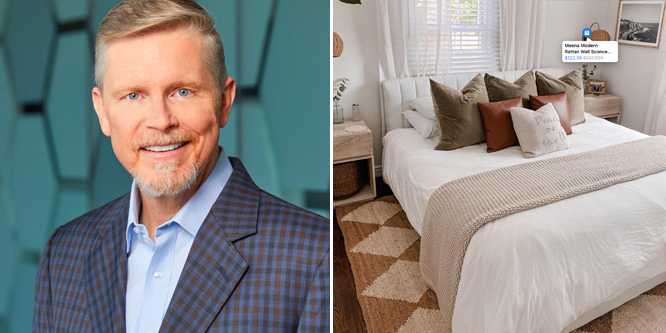
Overstock.com CEO Jonathan Johnson – Photos: Overstock.com
Overstock.com’s dropship model is margin-solid ‘come hell or high water’
Overstock.com had a challenging 2022, but it could have been worse.
The online furniture and home goods retailer reported a 30 percent year-over-year revenue decrease and a net loss of $35 million.
“2022 was a really difficult time because so many in our industry had excess inventory and were in the process of liquidating it. That put real pressure on pricing downward,” Overstock CEO Jonathan Johnson told RetailWire in an interview yesterday.
Mr. Johnson said that when rivals lowered prices, it put more of them in the same “smart value space” where Overstock operates. “It meant that we had to lower prices to be with them and the delta in the price comparison got smaller. Our smart value proposition may not have been as obvious to our customer,” he said.
Overstock expects its rivals’ inventory rationalization efforts to be complete by midyear, bringing a greater degree of pricing sanity back to the market. It is in this space that Mr. Johnson expects Overstock to shine.
The Overstock CEO pointed to his company’s understanding of its target customers as an organizational strength.
“The savvy shopper wants the best quality product for the money she’s willing to spend,” said Mr. Johnson “She may be willing to spend a lot. She may not want to spend a lot. She wants the most she can get for her dollar. We think that fair value is a place where we play and Wayfair doesn’t traditionally.”
Mr. Johnson said the other customer Overstock competes for is the reluctant “refresher.” This is someone “who doesn’t particularly like to shop, and when she shops, she knows what she wants. For her, we need product availability and to make her shopping experience easy from first browsing to post-purchase.”
Overstock’s CEO sees a competitive advantage for his company in its dropship network of about 2,600 suppliers. The system makes it easier to safeguard supplies with multiple patio furniture suppliers, for example. It also protects Overstock’s margins.
“Those flush with inventory liquidated it and hurt their margins,” he said. “Because we don’t own it, we can maintain our margins. And if the price goes down, we’ve negotiated a first cost concession from one of our partners. And that’s why come hell or high water, we’re at 20 to 23 percent gross margin.”
Discussion Questions
DISCUSSION QUESTIONS: How do you see Overstock.com positioned against its rivals in the furniture and home goods space for 2023? What is your evaluation of Overstock’s inventory-free dropship business model?


Prediction: The boast about maintaining gross margin between 20 percent and 23 percent, “come hell or high water”, will not age well. A 30 percent YOY revenue decrease means that customers found a lot of other avenues for finding value product. Some of those avenues may dry up, but if gross margins are so easy, then rebuilding the revenue seems like the priority.
My first reaction is that Mr. Johnson is a CEO who speaks of realities, not hype. What a pleasant surprise.
I like this business model. Assuming Overstock.com has built good relations with its partners, Overstock.com becomes a hero to the manufacturers for solving overstock issues. They deliver great prices to the customers. And by controlling the delivery process, they have expertise beyond what the partners could execute on their own.
The discount furniture space is very competitive and when competitors slash prices to liquidate excess inventory it squeezes everyone’s margins. Overstock’s increased use of drop-ship to reduce inventory risk is a smart strategy that will help protect margins. Excess inventory in any retail segment is an extremely costly problem and drop-ship is becoming more common and appealing for retailers.
The business started rebranding in early 2011 as “O.co” to simplify and unify its international operations, but interrupted this effort a few months later, citing consumer confusion over the new name, which utilized a Colombian country domain.https://en.wikipedia.org/wiki/Overstock.com
This is what many of us in the Bay Area know about them, as at the time they had naming rights to the Coliseum, and, suffice it to say, it left an impression of “not quite knowing what they’re doing.” I’m not sure that impression has been shaken (nor am I sure it should be).
Inventory-free businesses have plusses and minuses — there’s a reason, after all, why most businesses carry one — and I won’t venture a guess as to which one will win out here. As for the margin boast: it’s not hard to maintain margin if you have no concerns about how much you sell … actually making money is a harder trick to pull off.
The best merchants can manage margin with highly managed inventory. No inventory is more highly managed than drop ship. The challenge is maintaining revenue if the manufacturer has also tightened their inventory turn making availability of the highly desired product very limited. Nice to have the margin, but if the revenue isn’t there, neither are the profit $. It’s always a dance.